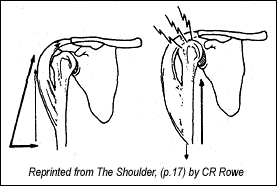Spearheaded by burgeoning scientific and clinical research literature, psychedelics have reached a level of media coverage and popular interest that has not been seen for over half a century. By “psychedelics,” we are referring to the unique class of substances that includes psilocybin (the active compound found in so-called “magic mushrooms”), LSD, dimethyltryptamine (DMT), ayahuasca, 5-MeO-DMT, and mescaline – each of which occurs in the natural world (except for LSD, which is a semi-synthetic compound).
Does Your Patient Really Need Acromioplasty?
Does your patient really need acromioplasty? The answer is probably no. Acromioplasty (usually surgical removal of the anterior portion of the acromion) is "the most commonly performed procedure to treat symptoms of impingement in the absence of a full thickness tear of the rotator cuff."1 Surgeons have been performing acromioplasty since Neer2 in 1972 stated that the principle cause of impingement was the abnormal morphology of the anterior acromion impinging on the superior or bursal side of the supraspinatus. This theory is based on an extrinsic pathology, i.e., something outside the tendon is pressing on it. While a small percentage of the population may be born with a hooked anterior acromion, the most common cause of impingement symptoms is intrinsic pathology.

The supraspinatus musculotendinous portion and insertion areas are the most frequently involved areas of pathology, especially on the articular or underside of the tendon, rather than the superior bursal side. An important function of the supraspinatus is its ability to compress the humeral head into the glenoid during glenohumeral elevation. If the supraspinatus is eccentrically overloaded and overused, not allowing it to completely repair itself, degeneration and weakness occurs intrinsically within the tendon. A weakened supraspinatus then allows what is called "deltoid shear": the muscle imbalance between the supraspinatus and deltoid allows the deltoid to abnormally migrate the humeral head superiorly during shoulder elevation.
The greater tuberosity and the rotator cuff then abnormally abut against the undersurface of the acromion and the coracoacromial ligament. (See the figure, which depicts independent deltoid muscle action without the stabilizing effect of the cuff muscles.) This type of impingement is secondary impingement, as differentiated from primary acromial impingement. Eventually this superior abutment can cause osteophytes on the undersurface of the acromion. So the intrinsic failure of the tendon allowing the deltoid shear may result in reactive osseous changes. A traction spur may also appear at the insertion of the coracoacromial ligament at the anteromedial corner of the acromion, due to the uncontrolled migration of the humeral head. These osteophytic spur-like formations are often reported to be abnormal hooked acromions (which they are not) and cause primary impingement.
An important function of the anterior acromion and coracoacromial ligament is to act as a necessary passive stabilizer against superior migration of the humeral head. If the primary problem is intratendinous degeneration (tendinosis) and not the hooked acromion, why remove the anterior portion of the acromion and resect the coracoacromial ligament? According to Budoff, et al,1 "acromioplasty disrupts the periosteum and cortical bone of the acromion, exposing a large surface of raw cancellous bone that may predispose to extensive scar formation. Subsequent fibrosis of the coracoacromial arch may result in decreased motion of the shoulder."
Another primary cause of impingement besides the injured, weakened and degenerative cuff is shoulder instability that may be related to the weakened cuff. Again, with instability there is superior abutment of the humeral head against the articular surface of the cuff, which can eventually affect the bursal side of the cuff. Instability is a common cause of impingement in the young adult. Surgeons have learned from experience to rarely perform acromioplasty on the young because it has never solved the underlying instability.
If surgery is needed for the degenerated tendon, proper procedure is to debride the degenerative tissue, which is the primary pathology, rather than automatically remove the acromion. Of course, osteophytes and spurs should be removed.
Before surgery for partial tears and impingement symptoms, at least three to six months of conservative care is recommended. Soft tissue therapy, using friction massage and Graston technique, has been shown to have a beneficial effect on degenerative tendinosis. Treatment can be directed to the involved portion of the cuff and the coracoacromial ligament. Strengthening of the cuff and parascapular muscles must also be emphasized.
References
- Budoff JE, Nirschl RP, Guidi EJ. Debridement of partial-thickness tears of the rotator cuff without acromioplasy. Focus on the rotator cuff. J Amer Acad of Orth Surg Jan/Feb, 1999;7(1).
- Neer CS II: Anterior acromioplasy for chronic impingement syndrome in the shoulder. A preliminary report. J Bone & Joint Surg Jan. 1972;54-A:41-50.
Warren Hammer,MS,DC,DABCO
Norwalk, Connecticut
softissu@optonline.net



